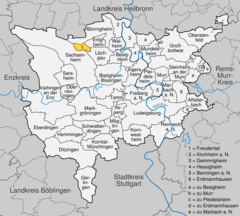Freudental
Freudental
Municipality in Baden-Württemberg, Germany
Freudental is a municipality in the district of Ludwigsburg, Baden-Württemberg, Germany.
You can help expand this article with text translated from the corresponding article in German. (February 2009) Click [show] for important translation instructions.
|



